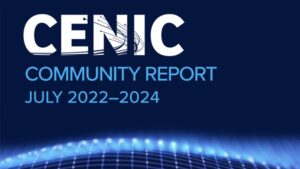- About
- Network
- Community
- Initiatives
- News
- Events
- Blog
- Publications

Learn What CENIC and Our Members Accomplished Together in the CENIC 2022-24 Community Report
Categories CCCs CSU Cultural & Scientific University of California K-12 Libraries Pacific Wave The CENIC Community
Tags community report
Network Innovations, Member Success Stories, Collaboration Opportunities, Backbone and Circuit Upgrades for Every Segment, and more updates
All of the achievements you’ll read about in the CENIC 2022-24 Community Report are natural extensions of both facets of our CENIC mission: to advance research and education statewide by providing the world-class computing network essential for innovation, collaboration, and economic growth; and to ensure broadband equity for all Californians.
In the report you will learn more about:
- The CalREN Backbone: Now operating at 400 Gbps with 800 Gbps on the way, CalREN now accepts native 400 Gbps handoffs at key backbone node sites and features upgraded network automation and security upgrades—and of course circuit upgrades for all segments as well.
- Circuit Upgrades for All Segments: Over 1,000 new circuits, and circuit upgrades, renewals, and relocations for all segments, keeping the state's K20 research and education community connected to one another and the world.
- The CENIC AI Resource (CENIC AIR): The most powerful and heavily used section of the National Research Platform (NRP), CENIC AIR also provides a smooth transfer path for network and big-data science between educational member segments, important in a state with an integrated master plan for education.
- Building Member Collaboration and Success: Learn about breathtaking cross-segmental innovations across all disciplines made possible by the collaborative atmosphere and advanced network our members have created through CENIC.
Related blog posts
CENIC and San Diego Supercomputer Center Create Sustainable Agriculture for California’s Future
CENIC’s networking and services, including CENIC AIR, can be a vital part of preparing new generations of farmers that will apply the latest technology to agriculture by turning the farm into an educational setting and improving the efficiency of farming as a career.
Advancing AI for California’s Community Colleges through Collaboration Across the CENIC Membership
It’s been eight months since the San Diego Community College District connected to CENIC AIR—and CENIC membership was essential at every step of the way.


